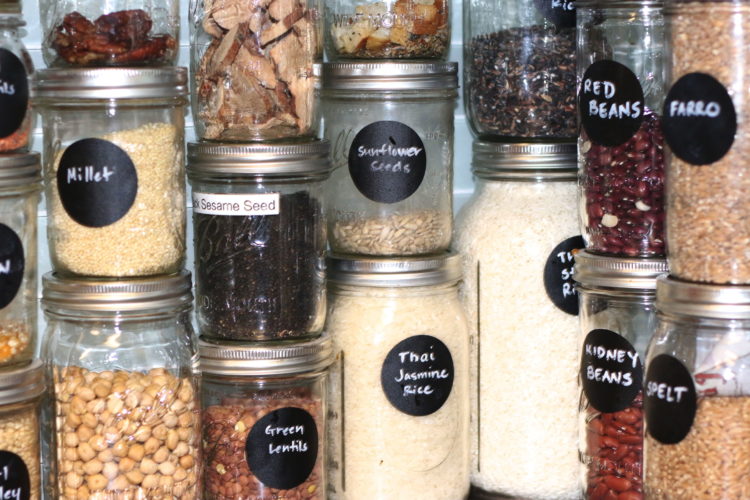Your Plant-Based Vegan Pantry
Consider these key items for your plant-based vegan pantry. Select organic, raw and unsalted ingredients when possible.
Being prepared in an organized kitchen will facilitate a more zen cooking experience
Cooking should be a positive, not stressful chore. Instead of running to the grocery store, whenever you need an ingredient, try to keep a variety of items stocked in your kitchen.
Vegan Pantry Items
- Grains
- Herbs
- Legumes
- Nuts
- Oils
- Seeds
- Spices
- Sweeteners
- Teas and Tisanes
- Other
Buy organic grains whenever possible. Buying in larger quantities and/or in bulk can save you a lot of money. We recommend washing your grains such as rice and quinoa thoroughly before cooking.
Whenever possible use organic herbs. Fresh herbs are great, but it’s convenient to have quality, dried herbs handy too. You can buy whole or ground herbs. With a mortar and pestle or herb/spice grinder you can customize to your desired consistency.
Although there’s nothing like fresh legumes (beans), sometimes you just want the convenience of cooking with boxed, canned or dried beans. Opt for organic which is readily available these days. Buying in larger quantities and/or in bulk packing case save you a lot of money.
When it comes to nuts, consider organic, raw and unsalted varieties. Sprouted nuts are usually easier to digest.
When incorporated into our recipes, use oils sparingly and organic whenever possible.
Choose organic, raw and unsalted seeds whenever possible. Sprouted seeds are typically easier to digest.
You should try and incorporate organic spices which are usually available whole or ground. With a mortar and pestle or spice/herb grinder you can also customize to your desired consistency.
Sweeteners are optional.
If you are a tea and tisane (herbal infusion) aficionado you will love how they enhance and elevate recipes.
Here are additional items to consider for your plant-based pantry.
Here are key ingredients to have on hand in your vegan pantry:
Grains
- Amaranth
- Buckwheat
- Corn Meal
- Farro
- Flour: Almond, Brown Rice, Chickpea, Oat and Teff
- Millet
- Oats: Rolled and Steel Cut
- Popcorn
- Quinoa
- Rice: Basmati (Brown), Black (Forbidden Rice), Brown (Short Grain and Long Gain) and Jasmine
- Spelt
Herbs
- Basil
- Cilantro
- Herbs de Provence
- Lemongrass
- Marjoram
- Mint: Peppermint or Spearmint
- Oregano
- Parsley
- Rosemary
- Sage
- Thyme
Legumes
- Black
- Cannellini
- Garbanzo (Chickpea)
- Kidney
- Lentils: Black Beluga, Brown and Green, Orange and Red
- Pinto
Nuts
- Almond
- Brazil
- Cashew
- Pecan
- Pistachio
- Walnut
Oils
Add oils sparingly or no added oils.
- Coconut Oil
- Extra Virgin Olive Oil (EVOO)
- Sesame Oil
Seeds
- Chia Seeds
- Flax Seeds
- Hemp Seeds
- Pumpkin Seeds
- Sesame Seeds: Black and White
- Sunflower Seeds
Spices
- Cardamom
- Cayenne
- Chili Powder
- Cinnamon: Cinnamon Sticks and Vietnamese
- Cumin
- Curry Powder
- Garam Masala
- Garlic Powder
- Ginger Powder
- Onion Powder
- Paprika
- Pepper: Black and White (Peppercorns or Ground)
- Salt: Celtic and Himalayan Sea Salt
- Turmeric
- Vanilla: Bean and Extract
- Za’atar
Sweeteners
- Agave Syrup
- Brown Rice Syrup
- Coconut Nectar
- Date Paste
- Maple Syrup
Teas and Tisanes
- Chamomile
- Ginger Tea
- Green Tea
- Lavender
- Matcha Powder
Other
- Apple Cider Vinegar (ACV)
- Arrowroot Powder
- Black Rice Noodles
- Brown Rice Noodles
- Cacao
- Chickpea Pasta
- Coconut: Flakes and Shredded
- Coconut Aminos
- Fruits: Cranberries, Dates, Goji Berries, Mulberries, Raisins and Sun-Dried Tomatoes
- Lentil Pasta
- Miso
- Mushrooms: Porcini, Reishi and Shiitake (Dried or Powder)
- Mustard
- Nutritional Yeast
- Rice Vinegar
- Sea Kelp Noodles
- Sea Vegetables: Agar Agar (Flakes or Powder), Dulse, Kelp, Kombu, Nori and Wakame
- Spirulina
- Tahini
- Tamari
You will find yourself reaching for the above-listed items the most. Remember to check the shelf life or expiration dates to ensure optimal freshness and potency of ingredients. Some pantry items, such as nuts are best stored in the refrigerator or freezer to slow down staling and prevent rancidity. There are many other healthy choices for a plant-based pantry and your selected products can be adjusted depending on your own tastes, health and dietary needs. Experimenting with different flavor profiles is part of the fun of plant-based cuisine.
Vegan Pantry Containers
For pantry organization, airtight glass containers are superior. Some people are concerned about having glass (especially around children or clumsy adults), so there are good options too for BPA-free plastic containers that can be reused. There are a variety or brands and sizes of containers that are low-cost and readily available for purchase.
Container Labels
Labeling your pantry items is also important. You can purchase and create a variety of labeling systems for your kitchen. Put a label on the side of the container for visibility and date/expiration and/or date of purchase on the bottom. For herbs, spices and typically smaller containers, you can also place labels on the top of the container lids as an alternative to side labels.
